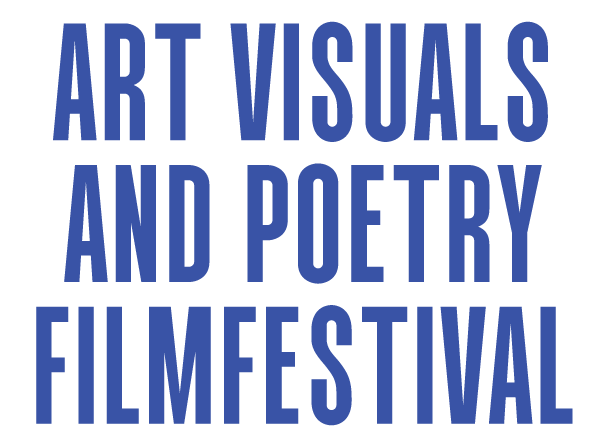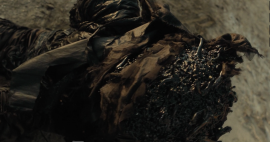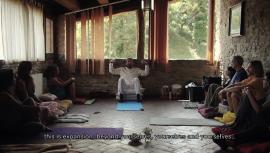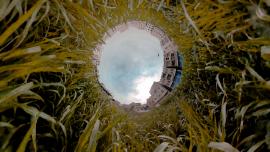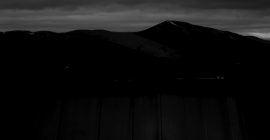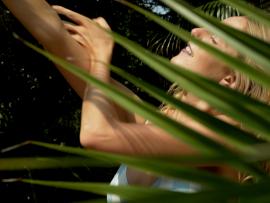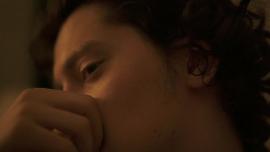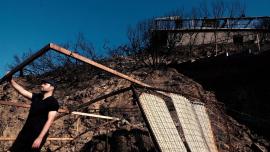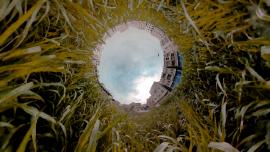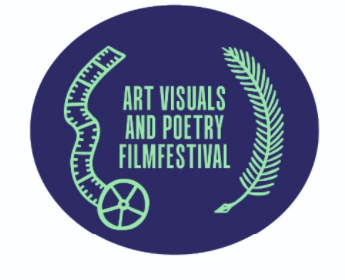
International Audience Award 2021
Opening Art Visuals & Poetry Film Festival 2021
Opening talks by
- Tanja Prusnik, president of the Künstlerhaus
- Sigrun Höllrigl, festival director
November 9, 2021 8pm
Location: Stadtkino im Künstlerhaus, Akademiestraße 13, 1010 Vienna
Free Entry - Online registration over eventbrite is required for all festival screenings. The online tickets have to be changed at the cinema desk against local cinema tickets.
This competition is based on international film entries, which have been curated by the festival team. The award-winner will be chosen by the audience.
Moderation: Katharina Wenty
For #climatestrike we wanted to shed light on a major environmental crisis that is already happening today and often overlooked. Desertification is a silent, deadly process that could force millions of people to abandon their homes in the coming years. The film is a collective effort of artists and friends to create something memorable, that will lodge ‚desertification‘ in our audience’s memory. This is our contribution to support the #unitednations and the #fao in combating desertification with the #greatgreenwall project. Shot on location in the deserts of Northern Sudan (Sahel-Zone) and Tabernas, Southern Spain.
A Common Future is an international artist community producing short films.
Loosely based on the article by Daniel Lumera; writer, lecturer, researcher, university professor and international reference point in the field of meditation (article included in the "World Report on Higher Education" of GUNI, UNESCO's Global University Network for Innovation). The movie tells, through the experience of three young researchers, Manuela, Julia and Marc, the possibility of understanding the concept of Revolution, no longer as a reaction to a state of wrong situations, but as a proactive expression of a new internal consciousness.
Giulia Efnael Viero was born as a photographer in 2008, within the Flux Lab Association of Turin, Laboratory of Integrated Arts, where she comes into contact with numerous artists of the Turin scene. Thanks to the winning of the "CRITICA IN MOVIMENTO" award, Studio 28 Tv, she enters also the world of video and she stared to collaborate with the Italian Web Television platform "Studio 28Tv" and the European one of "Share Culture Tv".Parallel to his work as a videomaker, he began a profound journey of inner research, through Yoga and meditation.
'No Words' is a lyrical film that laments the poet's loss of words as to what is happening to his beloved city Taiz and the situation in Yemen. It utilizes 360-degree footage to place the audience at the camera's point of view as an observer to what is occurring in the city. The melancholic images beautifully resonate with the mournful words to create a poetic feel surrounding the ongoing conflict.
Mariam Al-Dhubhani is a Yemeni-Russian award-winning journalist, filmmaker, and curator. She first pursued her passion for media during the 2011 Arab uprisings and co-founded her first media production. Her films have been screened globally in festivals such as Carthage, Interfilm, and Oaxaca. She also utilizes Virtual Reality in highlighting stories from Yemen.
Dark Myriad 7 (Тьма Тем 7) is a videopoem that aims to create a new type of poetic language, integrating spoken word with moving image to develop an non-illustrative style. By morphing faces and colours together with the use of dynamic lighting, this composition aims to weave together the fluidity of light and language.The videopoem presented here is part of an album called Dark Myriad (Тьма Тем). The project aims to integrate the audio-visual elements into inseparable rhythmic and rhyming compositions. The title Dark Myriad comes from an ancient Slavonic numbering system and signifies the biggest possible number, which is linguistically associated with darkness and its perceived infinity.
Eta Dahlia is London based Russian film maker and video-poet. Eta works in cinematic production, practicing both experimental and classical film techniques, while also recently moving into experimental poetry. His work combines minimalist Russian poetry with a range of other audio-visual media. One of his goals is to strive to achieve a universal type of a poem, where the understanding and appreciation of the piece is not limited to its original language. Recently, Eta Dahlia’s work has been exhibited at the National Poetry Library at Southbank Centre (London), the Centre for Recent Drawing (London), various poetry magazines and poetry film festivals.
3xShapes of Home is a experimental video in the intersection between an essay film, a structural experiment and a visual poem. In this video, the filmmaker revisits her place of origin, the small village of Strengelvåg in the Arctic North of Norway. Over a period of two years, she explores through her camera, how the architectures and topographies of that place, that is: the mountains, oceans and built environments, has shaped the filmmaker´s attachment to her childhood place, as well as her thinking.
Elisabeth Brun is an awarded filmmaker, video-artist and researcher, working in the intersection between documentary, philosophy and art/design. She holds a PhD in media studies from The University of Oslo, and has a background as a documentary film director in Norwegian public service broadcasting (NRK 2001-2014).
I have a small chalet, 120 kilometers north of Montreal. There are few neighbors all around and the forest behind seems to go on infinitely . In summer, surrounded with trees in full leafing, I feel alone in the world. So, this situation inspired me to write Edge of the disaster. I imagined the survivor of a cataclysm, protected by this cenacle of trees. How is it possible to remain present to the world when all which was the world is no more?
Swiss-born photographer and sound designer Mériol Lehmann has lived and worked in Quebec for more than 30 years. His exhibitions, installations and performances have been presented across Canada, Europe and Japan. He is currently completing his master’s degree in arts at Laval University, where he is investigating the relationship between humans and the geographic space they live in.
Sylvain Campeau holds a Ph. D. in French Literature. He has collaborated to several Canadian and European magazines (ETC, Ciel Variable, Parachute, PhotoVision, Ligeia and Papel Alpha). He has also curated some thirty exhibitions, presented in Canada and abroad, including the group exhibition Flambant vu. Corps, spectacles, held in September 2001 at Galerie Séquence in Saguenay and in September 2003 at Gallery 44 in Toronto, in conjunction with the Toronto International Media Art Biennal tranz “-“ tech, and Le cadre, la scène, le site, a survey of Québec photography over the past twenty years (in collaboration with Mona Hakim) circulating across Mexico. Also a poet, he has published five collections of poems, two essays on photography (Chambres obscures. Photographie et installation, Trois, 1995; OIKOS / Habitacles, SBC Gallery, 2008) and an anthology of poetry from Quebec.
At first glance, all you can notice is dreamy silence, as if you can clearly hear your own thoughts, that is reminiscing, location: unknown. Every photograph resembles an unfinished story, that blends perfectly into a collection of mesmerizing postcards from your private collection where you hide nostalgia. We couldn’t picture either one of our feelings more accurately. Miraculous. Miraculous. Miraculous.
Tina Bikic (1987) is a digital storyteller and filmmaker based in Berlin. Tina has finished MA in Comparative Literature wherein she became familiar with film. Aspiring to show both words and images on the screen, she combines dreamy images with poetic text, in order to present the experience of realizing an unprecedented, yet possible reality. The concept of unseen realities is visible through the main theme of her film which questions the places of our belonging and the state of in-between. Her poetical approach transforms a personal experience into a film using digital storytelling, experimental narrative, visual arts, and contemporary dance movement. Tina has debuted with the omnibus “In be(tween)aches of Berlin”.
An essay film about Chineseness
The red carpet house located at No. 800 Changle Road in Shanghai – the most central and expensive part of the city – but it is a dilapidated garden house. The red carpet house once belonged to a big boss in Shanghai. After the Cultural Revolution and subsequent social progress, the red carpet house was divided from one family’s house into the properties of many families...
As a research artist, Bei Yu focuses on exploring the impact of public environments and national memories on emotions (family-affection/love), language, interpersonal relationships and person-object relationships in daily life in cross-country and cross-culture environments. The “translation confusion” caused by cultural differences has become an active attitude here. The artist uses an “access-rejecting” / “inexplicable” narrative method to depict the complexity in Chinese communities in a different political framework and language environment.
"I see" is a fictionalized version adopted from real events of one of the chapters of the life of Iranian filmmaker and actor Arman Partovi in 2020. It is a film with an existentialist tinge, it is about a young man who is going through an existential crisis caused by quarantine. Faced with an unexpected event of forced lockdown, memories and thoughts of the past are present under the shadow of chaos guiding him from darkness to light through meditations on Genesis of the world that allows him to create a poetic dialogue with the Word of God and discover his identity in Him.
Arman Partovi was born in Iran in 1994. He got his B.A in Theater from Tehran University of Art in 2019. He has been working as an actor, performer, choreographer & researcher since 2015. "I see" is his first short film.
In this poetic live-action documentary the 2D animation -having a strong imprint upon abstraction- is used as a medium in three revealing shots. The poet's gaze appearing as a dead Fayum portrait is the first shot. And the other two shots depict the souls procession at fire-stricken town of Mati, where in July 2018 the deadliest fire in Greece, and internationally in the last decade, took place.
PANAGIOTIS KOUNTOURAS is a top graduate of Film Studies Department (Aristotle University of Thessaloniki). His films Heroes of the Flicks, A Box Made of Wood and Emoticon Man have been officially selected and awarded in several film festivals around the world. His films Heroes of the Flicks, A Box Made of Wood and Emoticon Man have been officially selected and awarded in several film festivals around the world. His latest short IVAN premiered in Leeds Film Festival 2018 and received the Jury Recognition Award in Bucharest Shorts. He has directed more than 60 commercials and corporate videos in advertising business, 120 TV show episodes and music videos for acclaimed Greek and international artists.
ARISTARCHOS PAPADANIEL studied Tourism Business Administration, Graphic Design and Animation. Author of the book “Greek Political Caricature. The Serious Side to a Funny Art”. Creator of the flipbook series “Pocket Cinema” and the poster book "A Comics Artist on TV". In 2005 he co-founded the creative studio/production company Syllipsis Ltd., where he produces visual communication through animation, illustration and graphic design. A number of his illustrations have been published by magazines, exhibited on galleries and broadcasted on various TV series and shows (e.g. “The X Factor”).
No Words" ist ein lyrischer Film, in dem der Dichter beklagt, dass ihm die Worte fehlen für das, was mit seiner geliebten Stadt Taiz und der Situation im Jemen geschieht. Der Film nutzt 360-Grad-Aufnahmen, um den Zuschauer als Beobachter der Geschehnisse in der Stadt an den Standpunkt der Kamera zu versetzen. Die melancholischen Bilder harmonieren wunderbar mit den schwermütigen Worten und erzeugen ein poetisches Gefühl in Bezug auf den anhaltenden Konflikt.
Mariam Al-Dhubhani ist eine jemenitisch-russische preisgekrönte Journalistin, Filmemacherin und Kuratorin. Ihre Leidenschaft für die Medien entdeckte sie erstmals während der arabischen Aufstände 2011 und war Mitbegründerin ihrer ersten Medienproduktion. Ihre Filme wurden weltweit auf Festivals wie Carthage, Interfilm und Oaxaca gezeigt. Sie setzt auch Virtual Reality ein, um Geschichten aus dem Jemen zu erzählen.
